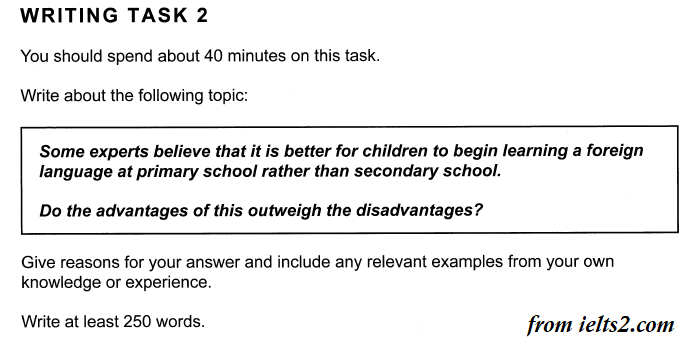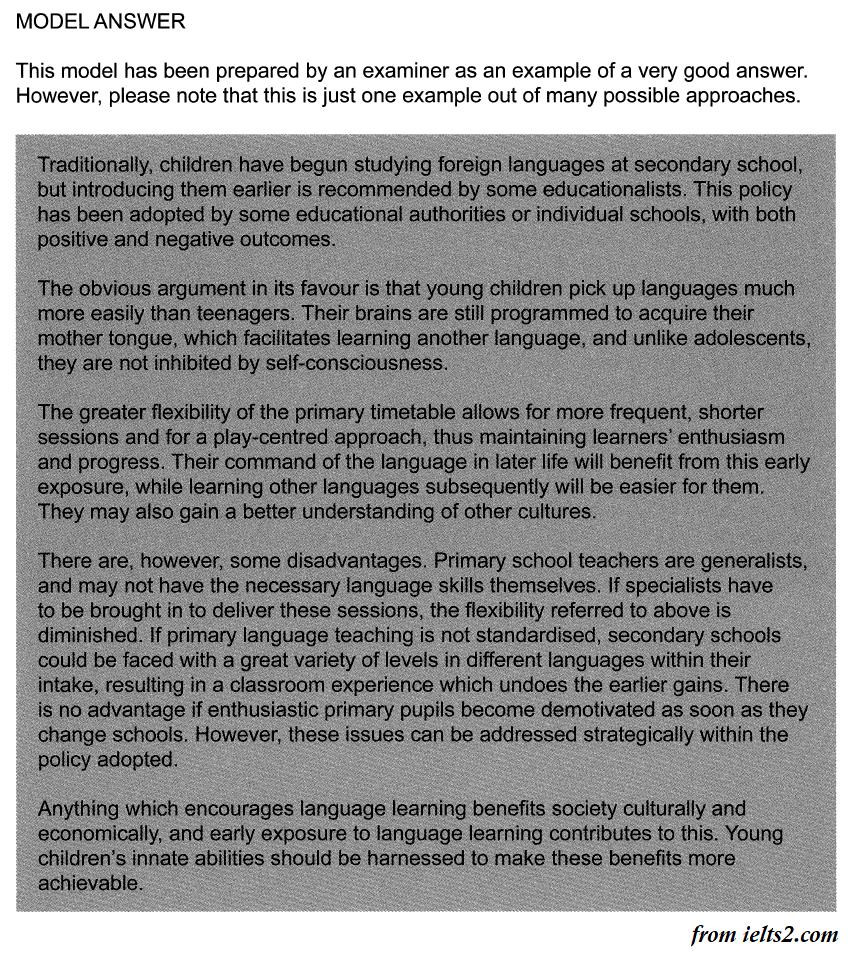
نمونه رایتینگ آیلتس – Learning Language Primary School
در چندین بخش از سایت ielts2 به ارائه سمپل های رایتینگ آیلتس در سطح نمره های 7 و 7.5 و 9 پرداختیم که مورد توجه عزیزان بوده است. در این صفحه نیز یک نمونه رایتینگ از کمبریج آیلتس 9 تست 1 تسک 2 به همراه یک نمونه پاسخ در سطح نمره 9 و یک نمونه پاسخ ساده تر در سطح نمره 7 خواهیم پرداخت که این نمونه توسط مهندس ابوالقاسمی با نمره 8 رایتینگ آیلتس و با هدف راهنمایی زبان آموزان تنظیم شده است.
زبان آموزان گرامی پیش از بررسی رایتینگ حتما نگاهی به معیارهای تعیین نمره رایتینگ در جدول Band Score Descriptor داشته باشند. در این جدول استاندارد که توسط مالکین آیلتس منتشر شده به صورت دقیق به بررسی سنجه های مورد نظر اگزمینر برای تعیین هر یک از 4 مورد اصلی پرداخته شده است. این جدول به همراه توضیح صوتی 10 دقیقه ای مهندس ابوالقاسمی را در این صفحه ببینید.
.
سمپل برای رایتینگ آیلتس آکادمیک نمره 7 – Learning Language Primary School
.
نمونه مقدمه 2 جمله ای:
The age for learning a second language has decreased over the past few decades. Learning a new language in primary school rather than secondary school has both advantages and disadvantages. (30 words)
.
.
نمونه نوشته شده توسط مهندس ابوالقاسمی(در سطح نمره 7)
The field of education has always been a source of controversy. While some argue that pupils benefit more if a second language is taught during the first few years of education, instead of the secondary school, others disagree. (39 words)
There are obvious benefits when students in their very first years are asked to learn a foreign language. First of all, there is less embarrassment for them since they are not criticized by their peers. Students in primary school do not form small groups to exclude other classmates. This sense of belonging to a larger group of the whole classroom helps them practice the language they are supposed to acquire. Moreover, it is widely believed that it is in human nature to learn a language without much effort at the very first years of life. By the time they are teenagers, this precious ability is long gone and much more enthusiasm and commitment is required to produce the same results. (120 words)
There are, however, some disadvantages too. First of all, since students may come from various families with different cultural background, mastering a second language may be discouraged in some cases. It is a fact that bilingualism is not welcomed in some communities even in western countries. Therefore, some students may not be able to perform in a satisfactory level. In secondary school, however, they are old enough to make their own decisions or fight back obstacles. Secondly, modern teaching methods to children is fundamentally different and required proper training and knowledge. This may be a challenge in developing countries where good teachers of a second language are scarce even in large cities. (112 words)
In conclusion, acquiring a new language at an earlier age presents opportunities for students but at the same time it creates problems for both students and schools, so there always seems to be a trade off. (36 words)
Total = (306 words)
.
.
لغات و ساختارهای پیشنهادی مدرس برای این تاپیک
Bilingualism /// to pick up a language /// proficiency in other languages /// a command of new language /// confusion /// to master a language /// to develop vocabulary /// an integral part of education curriculum /// mother tongue interference /// syllabuses to cater for the range of students /// removal of perceived barriers /// to boost problem-solving, critical-thinking and the ability to multitask /// uninhibited by the fear of making mistakes /// a positive correlation to cognitive development /// mandated requirement of language learning /// opening up their world literally and figuratively ///to display more positive attitudes to … /// a significant competitive advantage over monolingual peers. /// decisions in second language are more reason-driven /// empowers us to access information that would otherwise be off-limits /// to communicate seamlessly with customers in overseas markets /// to navigate multilingual environments /// opening a world of opportunities /// to make a tremendous difference /// to draw on the existing bilingual capacity within the community /// a marked discrepancy in the geographical distribution of /// quality teachers of languages /// increasing level of frustration and dropout rate /// the fear of ridicule /// self-imposed barriers to effective communication /// a virtually unexplored educational practice /// hardly produce the expected results /// causes negative attitudes towards foreign language learning /// resistance and lack of motivation ///
.
سمپل برای رایتینگ آیلتس آکادمیک نمره 9 – Learning Language Primary School
نمونه زیر توسط اگزمینر نوشته شده و در پایان کتاب کمبریج آیلتس 9 به عنوان الگو در دسترس می باشد(دانلود این کتاب با کیفیت بالا) سطح این نمونه نمره 8.5 تا 9 براورد میشود.
.
نمونه رایتینگ خوب نوشته شده توسط زبان آموزان دوره اردیبهشت 1400
Nowadays, learning a foreign language has become an important part of the school’s curriculum. Although some opine that pupils gain more benefit from learning a language at primary school rather than in high school, others disagree.
Learning a foreign language at an early age has several positive outcomes. First of all, students in primary school have more free time. Since they have fewer courses and assignments, they are not required to spend considerable time on school-related tasks. Consequently, they can devote adequate time to practicing and broadening their knowledge of language. Secondly, picking up a language is much easier for primary school pupils compared to adolescents. Because of having an excellent memory at a young age, they can quickly learn and master a language. They can learn a language more efficiently by imitating people around them or watching cartoons and copying phrases, and proper usage of the memorized phrases unconsciously, and all this knowledge will always remain in their memory.
On the other hand, learning a second language in primary school has some drawbacks. First of all, giving lots of homework to students at an early age can create stress for them, especially if they are reluctant. So, this can lead to a lack of motivation and also have detrimental effects on their education, and some may consider dropping out. Secondly, learning two languages simultaneously can be a demanding task. Since, in elementary school, students are in the process of learning their first language, they still need to work on the improvement of their mother tongue to master it. This can result in grammar and vocabulary confusion in both languages.
In conclusion, although learning a language for all pupils is an essential skill, and they would gain considerable advantages from studying it, it also has disadvantages that should not be ignored.
.
نمونه رایتینگ های آیلتس – بیشتر بخوانید
در پایان میتوانید برای دریافت جدیدترین کتاب ها و جزوه های آیلتس در کانال دانلودی منابع آیلتس (https://t.me/ielts2official) و همچنین برای انجام تمرین های روزانه در گروه تست زنی آیلتس (https://t.me/ielts2Group) ما همراه باشید.






